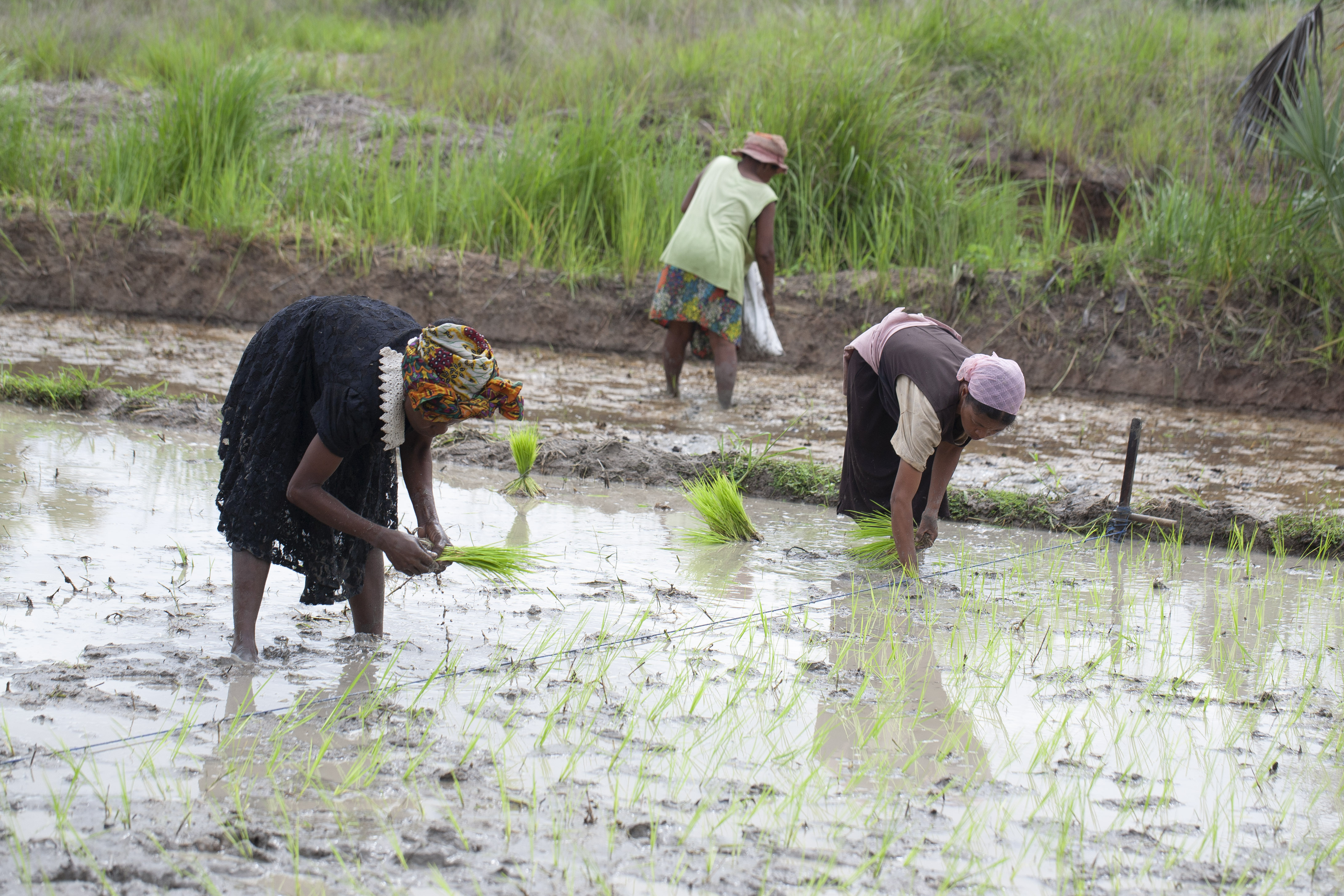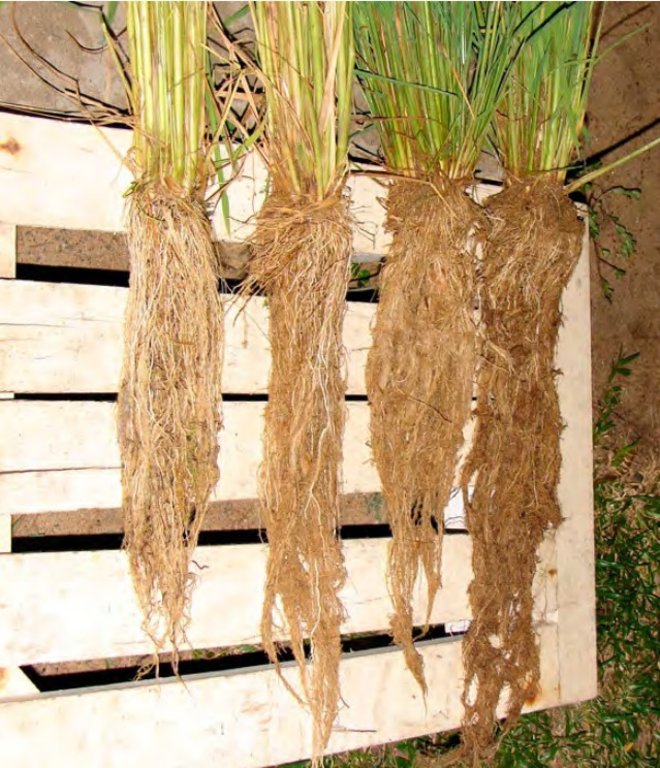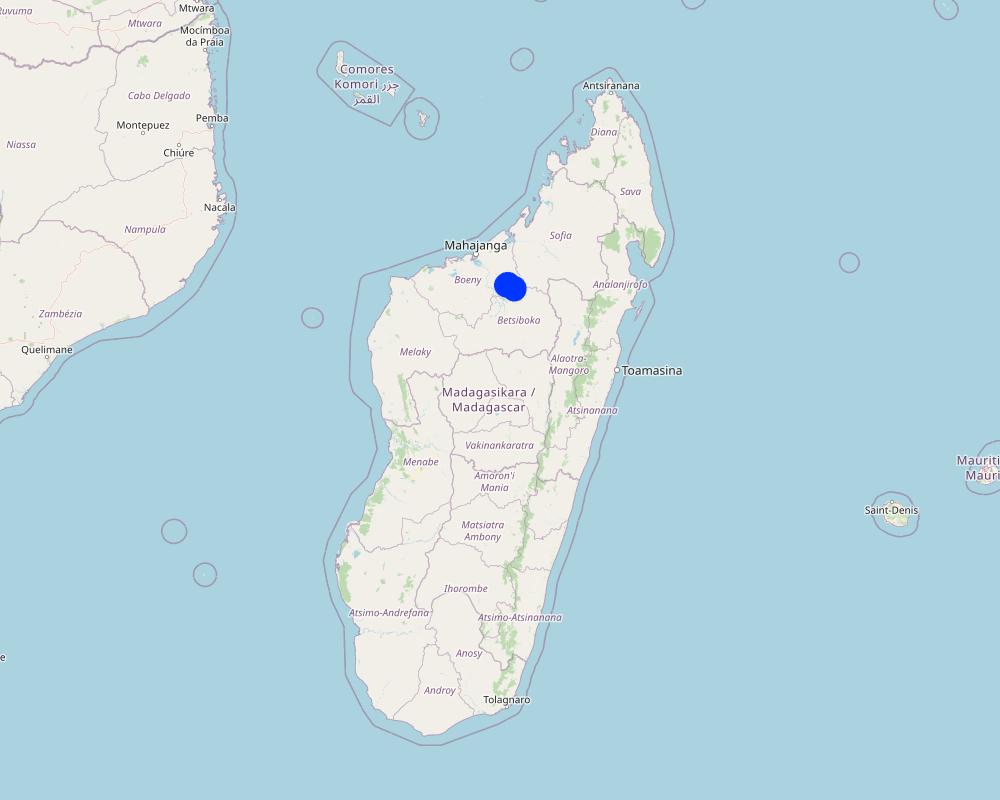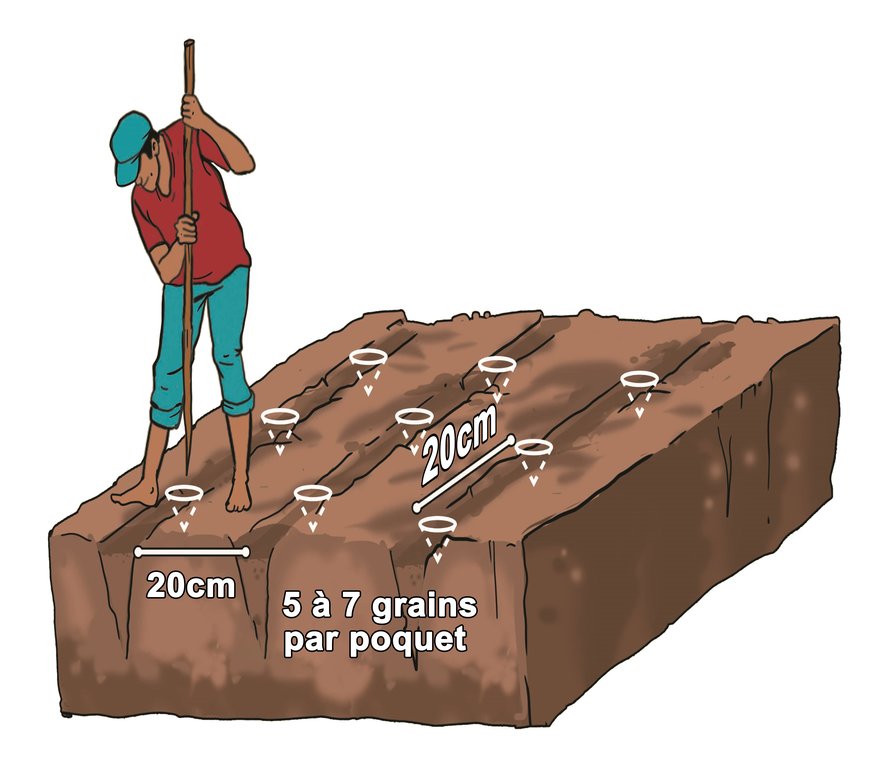Cultivation of Rice Varieties Suited to Fields with Poor Drainage [Madagascar]
- Creation:
- Update:
- Compiler: Harifidy RAKOTO RATSIMBA
- Editors: Felana Nantenaina RAMALASON, Dimby RAHERINJATOVOARISON, Siagbé Golli, Tahiry Ravivonandrasana, Natacha Rabeary, Tabitha Nekesa, Ahmadou Gaye
- Reviewers: William Critchley, Rima Mekdaschi Studer
Fambolena vary amin'ny toerana saro-drano (Kapilavaky)
technologies_6476 - Madagascar
View sections
Expand all Collapse all1. General information
1.2 Contact details of resource persons and institutions involved in the assessment and documentation of the Technology
Key resource person(s)
land user:
RAVELO Francois
Madagascar
land user:
FARANTSA
Madagascar
land user:
DEZY Honoré
Madagascar
land user:
NATHO Jinah
Madagascar
land user:
BEMIAFARA
Madagascar
Name of project which facilitated the documentation/ evaluation of the Technology (if relevant)
Soil protection and rehabilitation for food security (ProSo(i)l)Name of the institution(s) which facilitated the documentation/ evaluation of the Technology (if relevant)
Groupement Semis Direct de Madagascar (SD MAD) - MadagascarName of the institution(s) which facilitated the documentation/ evaluation of the Technology (if relevant)
Deutsche Gesellschaft für Internationale Zusammenarbeit (GIZ)1.3 Conditions regarding the use of data documented through WOCAT
The compiler and key resource person(s) accept the conditions regarding the use of data documented through WOCAT:
Yes
1.4 Declaration on sustainability of the described Technology
Is the Technology described here problematic with regard to land degradation, so that it cannot be declared a sustainable land management technology?
No
2. Description of the SLM Technology
2.1 Short description of the Technology
Definition of the Technology:
A Rice Field with Poor Drainage (RMME) is a cultivated rice field enclosed by embankments, relying on an irregular water supply, and facing potential water scarcity risks at the onset, during, or towards the conclusion of the cropping cycle. Specific rice varieties are particularly well-suited to this type of rice cultivation.
2.2 Detailed description of the Technology
Description:
A Rice Field with Poor Drainage (RMME) is a cultivated rice field enclosed by embankments, relying on an irregular water supply, and facing potential water scarcity risks at the onset, during, or towards the conclusion of the cropping cycle. Specific rice varieties, characterized by extended and rapidly growing roots, are particularly well-suited to this type of rice cultivation. These roots enable the plants to access deeper water resources, in the absence of rainfall throughout the crop cycle.
RMME may be situated in lowlands or along the banks of floodable rivers, often on levelled plots enclosed by dikes. Water is sourced from springs, river intakes, or through brief flooding. However, careful management of the water level within the rice field is essential.
Transplanting or dry-sowing methods can be employed under RMME. Dry sowing is preferred when the availability of water in the rice field is uncertain, an increasingly common scenario with climate change. The nursery can be placed near the rice field, on a plot with water resources, or in proximity to the village.
The rice varieties selected for RMME cultivation are characterized by long roots and rapid growth, with examples including Sebota 70, 281, and 410 (with a 105-day vegetative cycle). During transplanting, it is crucial to ensure that the age of the seedlings does not exceed 15 to 20 days. This precaution prevents the young rice plants from rooting deeply in the nursery, reducing the risk of root breakage during transplanting, which could otherwise hinder their tillering capacity. Transplanting is carried out in rows.
For fertile or well-fertilized soils, the recommended spacing is 20 cm * 20 cm. This configuration allows for the manual rotary hoe to pass in both directions during weeding. In less fertile soils, the spacing between rows remains 20 cm, but plants within the same row are spaced 10 cm apart. In this scenario, the rotary hoe only needs to pass through one row.
.
2.3 Photos of the Technology
2.5 Country/ region/ locations where the Technology has been applied and which are covered by this assessment
Country:
Madagascar
Region/ State/ Province:
Boeny
Further specification of location:
Tsaramandroso, Ambondromamy
Specify the spread of the Technology:
- evenly spread over an area
If precise area is not known, indicate approximate area covered:
- < 0.1 km2 (10 ha)
Is/are the technology site(s) located in a permanently protected area?
No
Map
×2.6 Date of implementation
Indicate year of implementation:
2019
If precise year is not known, indicate approximate date:
- less than 10 years ago (recently)
2.7 Introduction of the Technology
Specify how the Technology was introduced:
- through projects/ external interventions
Comments (type of project, etc.):
GIZ ProSoil Madagascar
3. Classification of the SLM Technology
3.1 Main purpose(s) of the Technology
- improve production
- adapt to climate change/ extremes and its impacts
- create beneficial economic impact
3.2 Current land use type(s) where the Technology is applied
Land use mixed within the same land unit:
No

Cropland
- Annual cropping
Annual cropping - Specify crops:
- cereals - maize
- cereals - rice (upland)
- legumes and pulses - beans
- legumes and pulses - peas
- oilseed crops - groundnuts
- vegetables - root vegetables (carrots, onions, beet, other)
- Cowpeas
Number of growing seasons per year:
- 2
Specify:
November to March for rice, then April to July for other crops (cowpeas, mung beans, corn, peanuts).
Is intercropping practiced?
No
Is crop rotation practiced?
Yes
If yes, specify:
Cereals in one year, then legumes and oilseeds in the second, and so on.
3.3 Has land use changed due to the implementation of the Technology?
Has land use changed due to the implementation of the Technology?
- No (Continue with question 3.4)
3.4 Water supply
Water supply for the land on which the Technology is applied:
- mixed rainfed-irrigated
3.5 SLM group to which the Technology belongs
- rotational systems (crop rotation, fallows, shifting cultivation)
- improved plant varieties/ animal breeds
- surface water management (spring, river, lakes, sea)
3.6 SLM measures comprising the Technology

agronomic measures
- A1: Vegetation/ soil cover
- A5: Seed management, improved varieties
3.7 Main types of land degradation addressed by the Technology

biological degradation
- Bq: quantity/ biomass decline
3.8 Prevention, reduction, or restoration of land degradation
Specify the goal of the Technology with regard to land degradation:
- adapt to land degradation
4. Technical specifications, implementation activities, inputs, and costs
4.1 Technical drawing of the Technology
Technical specifications (related to technical drawing):
Rice can be sown directly with sticks (vary tomboka) at a rate of 5 to 7 grains per seed hole, if water is not available on the planting date. On more fertile soils, it is possible to maintain a spacing 20 cm apart and the rice bunches on the same row 20 cm apart.
Author:
GIZ ProSoil Madagascar, GSDM
Date:
05/19/2022
Technical specifications (related to technical drawing):
The optimal transplanting period falls within a 15 to 20-day window, aiming to discourage the development of deep roots in the nursery by young rice plants. It is crucial, during this phase, to plant the seedlings with their roots reaching a maximum depth of 2 to 3 cm into the soil. In less fertile soils, the spacing between rows remains at 20 cm, while the plants within the same row are positioned 10 cm apart.
Author:
GIZ ProSoil Madagascar, GSDM
Date:
05/19/2022
4.2 General information regarding the calculation of inputs and costs
Specify how costs and inputs were calculated:
- per Technology area
Indicate size and area unit:
1 hectare
other/ national currency (specify):
ariary
If relevant, indicate exchange rate from USD to local currency (e.g. 1 USD = 79.9 Brazilian Real): 1 USD =:
4300.0
Indicate average wage cost of hired labour per day:
5000
4.3 Establishment activities
| Activity | Timing (season) | |
|---|---|---|
| 1. | Cleaning of the plot | November-December |
| 2. | Soil cultivation (plow and harrow) | November-December |
| 3. | Nursery preparation for rice seedlings and sowing | December-January |
| 4. | Transplanting | December-January |
4.4 Costs and inputs needed for establishment
| Specify input | Unit | Quantity | Costs per Unit | Total costs per input | % of costs borne by land users | |
|---|---|---|---|---|---|---|
| Labour | Cleaning of the plot | man-days | 20.0 | 10000.0 | 200000.0 | 100.0 |
| Labour | Nursery preparation for rice seedlings and sowing | man-days | 8.0 | 5000.0 | 40000.0 | 100.0 |
| Labour | Transplanting | man-days | 20.0 | 5000.0 | 100000.0 | 100.0 |
| Equipment | Soil cultivation (plow and harrow) | animal traction | 16.0 | 20000.0 | 320000.0 | 100.0 |
| Equipment | Hoe | Number | 6.0 | 10000.0 | 60000.0 | 100.0 |
| Equipment | Plough | Number | 1.0 | 250000.0 | 250000.0 | 100.0 |
| Equipment | Fork | Number | 2.0 | 15000.0 | 30000.0 | 100.0 |
| Equipment | Watering can | Number | 4.0 | 30000.0 | 120000.0 | |
| Plant material | Rice seeds (Sebota 70, 281) | kg | 40.0 | 3000.0 | 120000.0 | |
| Fertilizers and biocides | Fertilizer | kg | 40.0 | 3000.0 | 120000.0 | 100.0 |
| Total costs for establishment of the Technology | 1360000.0 | |||||
| Total costs for establishment of the Technology in USD | 316.28 | |||||
If land user bore less than 100% of costs, indicate who covered the remaining costs:
GIZ ProSoil Madagascar
4.5 Maintenance/ recurrent activities
| Activity | Timing/ frequency | |
|---|---|---|
| 1. | Weeding | Twice, 1 month after planting |
| 2. | Treatment with biocides | Three times, 1 month after planting |
4.6 Costs and inputs needed for maintenance/ recurrent activities (per year)
| Specify input | Unit | Quantity | Costs per Unit | Total costs per input | % of costs borne by land users | |
|---|---|---|---|---|---|---|
| Labour | Weeding | Man-days | 36.0 | 5000.0 | 180000.0 | 100.0 |
| Labour | Treatment with biocides | Man-days | 5.0 | 5000.0 | 25000.0 | 100.0 |
| Equipment | Sprayer | Number | 2.0 | 80000.0 | 160000.0 | 100.0 |
| Equipment | Weeder | Number | 3.0 | 20000.0 | 60000.0 | 100.0 |
| Fertilizers and biocides | Biocides | litre | 6.0 | 32000.0 | 192000.0 | 100.0 |
| Total costs for maintenance of the Technology | 617000.0 | |||||
| Total costs for maintenance of the Technology in USD | 143.49 | |||||
4.7 Most important factors affecting the costs
Describe the most determinate factors affecting the costs:
Tillage equipment and planting tools
5. Natural and human environment
5.1 Climate
Annual rainfall
- < 250 mm
- 251-500 mm
- 501-750 mm
- 751-1,000 mm
- 1,001-1,500 mm
- 1,501-2,000 mm
- 2,001-3,000 mm
- 3,001-4,000 mm
- > 4,000 mm
Specify average annual rainfall (if known), in mm:
1400.00
Agro-climatic zone
- sub-humid
5.2 Topography
Slopes on average:
- flat (0-2%)
- gentle (3-5%)
- moderate (6-10%)
- rolling (11-15%)
- hilly (16-30%)
- steep (31-60%)
- very steep (>60%)
Landforms:
- plateau/plains
- ridges
- mountain slopes
- hill slopes
- footslopes
- valley floors
Altitudinal zone:
- 0-100 m a.s.l.
- 101-500 m a.s.l.
- 501-1,000 m a.s.l.
- 1,001-1,500 m a.s.l.
- 1,501-2,000 m a.s.l.
- 2,001-2,500 m a.s.l.
- 2,501-3,000 m a.s.l.
- 3,001-4,000 m a.s.l.
- > 4,000 m a.s.l.
Indicate if the Technology is specifically applied in:
- not relevant
5.3 Soils
Soil depth on average:
- very shallow (0-20 cm)
- shallow (21-50 cm)
- moderately deep (51-80 cm)
- deep (81-120 cm)
- very deep (> 120 cm)
Soil texture (topsoil):
- medium (loamy, silty)
- fine/ heavy (clay)
Soil texture (> 20 cm below surface):
- medium (loamy, silty)
- fine/ heavy (clay)
Topsoil organic matter:
- medium (1-3%)
5.4 Water availability and quality
Ground water table:
5-50 m
Availability of surface water:
medium
Water quality (untreated):
poor drinking water (treatment required)
Water quality refers to:
ground water
Is water salinity a problem?
No
Is flooding of the area occurring?
Yes
Regularity:
episodically
Comments and further specifications on water quality and quantity:
Flooding during the rainy season only
5.5 Biodiversity
Species diversity:
- medium
Habitat diversity:
- low
Comments and further specifications on biodiversity:
This region boasts a diverse array of plant and animal species, with some being native. However, this biodiversity is relatively moderate when compared to other parts of the island. In terms of habitats, approximately 20% of the region comprises suitable environments for supporting this biodiversity, including forests, water bodies, mangroves, and more, although this percentage remains relatively low.
5.6 Characteristics of land users applying the Technology
Sedentary or nomadic:
- Sedentary
Market orientation of production system:
- mixed (subsistence/ commercial)
Off-farm income:
- 10-50% of all income
Relative level of wealth:
- average
Individuals or groups:
- individual/ household
- groups/ community
Level of mechanization:
- manual work
- animal traction
Gender:
- women
- men
Age of land users:
- youth
- middle-aged
5.7 Average area of land used by land users applying the Technology
- < 0.5 ha
- 0.5-1 ha
- 1-2 ha
- 2-5 ha
- 5-15 ha
- 15-50 ha
- 50-100 ha
- 100-500 ha
- 500-1,000 ha
- 1,000-10,000 ha
- > 10,000 ha
Is this considered small-, medium- or large-scale (referring to local context)?
- small-scale
5.8 Land ownership, land use rights, and water use rights
Land ownership:
- individual, not titled
- individual, titled
Land use rights:
- individual
Water use rights:
- open access (unorganized)
Are land use rights based on a traditional legal system?
Yes
Specify:
The person looking after the land owns it.
5.9 Access to services and infrastructure
health:
- poor
- moderate
- good
education:
- poor
- moderate
- good
technical assistance:
- poor
- moderate
- good
employment (e.g. off-farm):
- poor
- moderate
- good
markets:
- poor
- moderate
- good
energy:
- poor
- moderate
- good
roads and transport:
- poor
- moderate
- good
drinking water and sanitation:
- poor
- moderate
- good
financial services:
- poor
- moderate
- good
6. Impacts and concluding statements
6.1 On-site impacts the Technology has shown
Socio-economic impacts
Production
crop production
Quantity before SLM:
0 bag
Quantity after SLM:
15 bags
crop quality
fodder production
fodder quality
Income and costs
expenses on agricultural inputs
farm income
workload
Socio-cultural impacts
food security/ self-sufficiency
Ecological impacts
Soil
soil moisture
Biodiversity: vegetation, animals
pest/ disease control
Specify assessment of on-site impacts (measurements):
These are estimates provided by the farmers interviewed.
6.2 Off-site impacts the Technology has shown
Specify assessment of off-site impacts (measurements):
no impact
6.4 Cost-benefit analysis
How do the benefits compare with the establishment costs (from land users’ perspective)?
Short-term returns:
positive
Long-term returns:
very positive
How do the benefits compare with the maintenance/ recurrent costs (from land users' perspective)?
Short-term returns:
positive
Long-term returns:
very positive
6.5 Adoption of the Technology
- single cases/ experimental
6.6 Adaptation
Has the Technology been modified recently to adapt to changing conditions?
No
6.7 Strengths/ advantages/ opportunities of the Technology
| Strengths/ advantages/ opportunities in the land user’s view |
|---|
| Increased rice production (self-sufficiency). |
| Increased source of income due to a surplus in rice production. |
| Reduced use of seeds due to a limited number of seeds planted. |
| Possible reproduction of rice seeds suitable for rice fields with poor drainage. |
| Strengths/ advantages/ opportunities in the compiler’s or other key resource person’s view |
|---|
| Farmers can adapt to the effects of climate change, especially as far as food is concerned, since the rice varieties used can survive adverse conditions (excess water followed by drought). |
| Reduced risk of water shortage at the end of the cycle (shorter rainy season, drought periods, etc.). |
6.8 Weaknesses/ disadvantages/ risks of the Technology and ways of overcoming them
| Weaknesses/ disadvantages/ risks in the compiler’s or other key resource person’s view | How can they be overcome? |
|---|---|
| Rice varieties that are suitable for rice fields with poor drainage are fast-growing and need to be transplanted without delay. | Transplanting should be carried out at the right time to ensure that the plants to be transplanted have not reached too advanced a stage of growth. |
7. References and links
7.1 Methods/ sources of information
- field visits, field surveys
Five (5) fields visited
- interviews with land users
Five (5) farmers interviewed
- compilation from reports and other existing documentation
GIZ ProSoil Madagascar technical sheet
When were the data compiled (in the field)?
01/31/2023
7.2 References to available publications
Title, author, year, ISBN:
Région Boeny, 2016, "Schéma Régional d’Aménagement du Territoire de la Région Boeny"
Available from where? Costs?
Boeny Region Hotel
Title, author, year, ISBN:
GIZ ProSol Madagascar, 2022, "Livret des Paysans Relais"
Available from where? Costs?
GIZ ProSol Madagascar
Title, author, year, ISBN:
GIZ ProSol Madagascar, 2022, Poster "Riziculture à Mauvaise Maîtrise d’Eau"
Available from where? Costs?
GIZ ProSol Madagascar
Title, author, year, ISBN:
A. L. RANDRIANAIVOMANANA, E. Penot, J. C. Rakotondravelo, 2010, "Innovation et diffusion encadrée des techniques de riziculture améliorée anti risques en zone RMME au lac Alaotra"
Available from where? Costs?
https://agritrop.cirad.fr/558956/1/document_558956.pdf
Title, author, year, ISBN:
V. P. Rasoamanana , 2010, "Etude sur la diffusion latérale des systèmes techniques améliorés en zones RMME au lac Alaotra"
Available from where? Costs?
https://agritrop.cirad.fr/570654/1/document_570654.pdf
7.3 Links to relevant online information
Title/ description:
OPERATION RIZIERES A MAUVAISE MAITRISE D’EAU LAC ALAOTRA 2004 – 2005
URL:
http://madadoc.irenala.edu.mg/documents/v02488_RIZ.pdf
Title/ description:
GSDM, "Culture de riz sur RMME Rizières à Mauvaise Maîtrise de l’Eau"
URL:
https://gsdm-mg.org/wp-content/files/Fiche_technique__Voly_vary_saro-drano_RMME_GSDM__TFNAC.pdf
Links and modules
Expand all Collapse allLinks
No links
Modules
No modules








